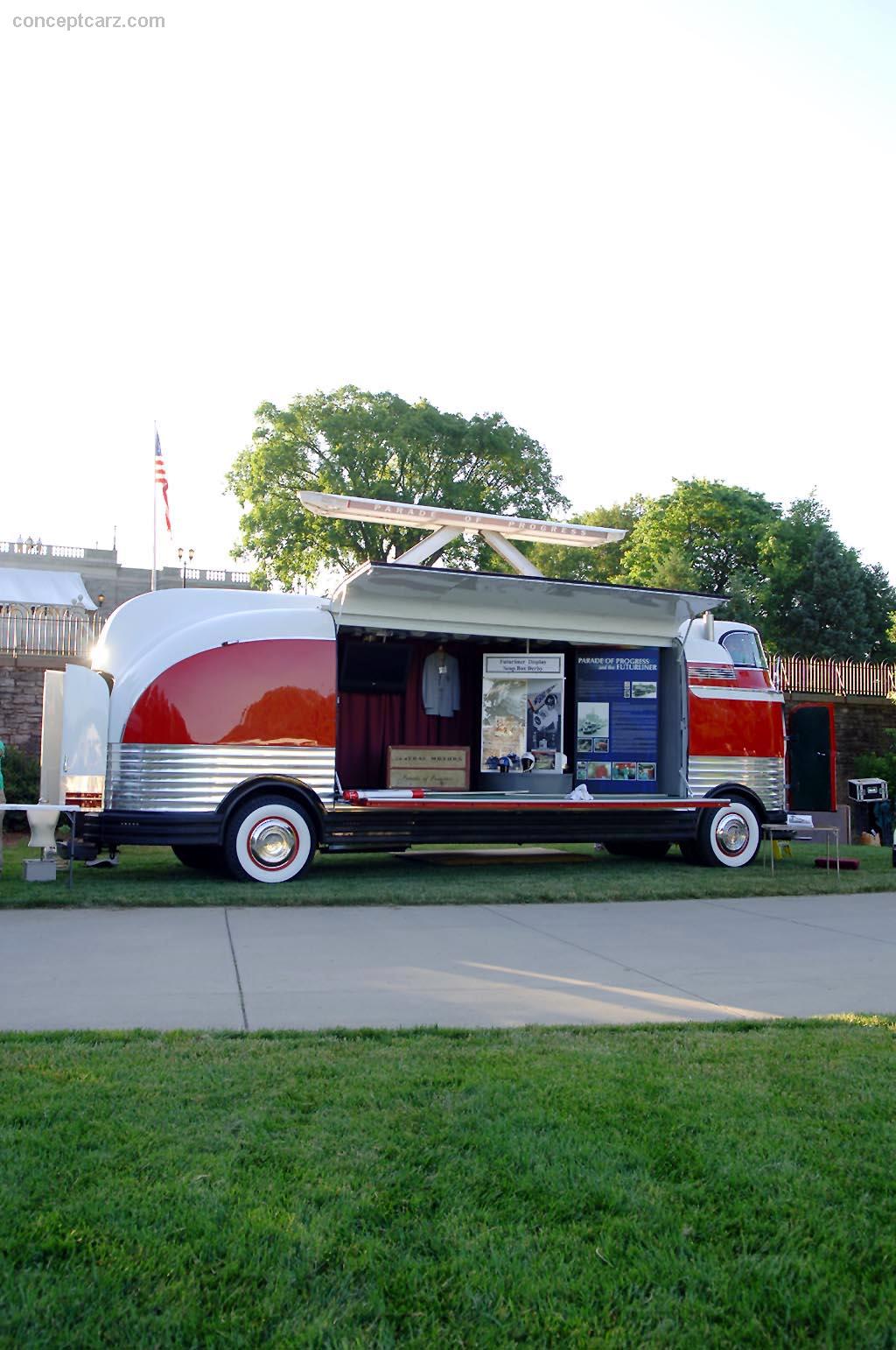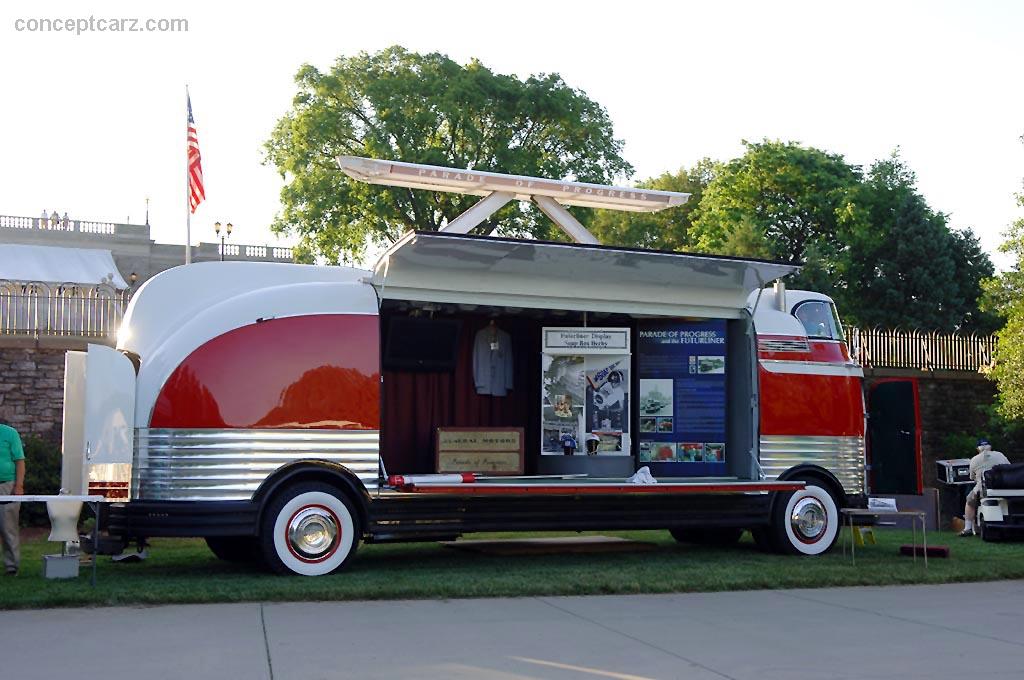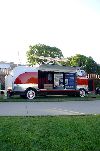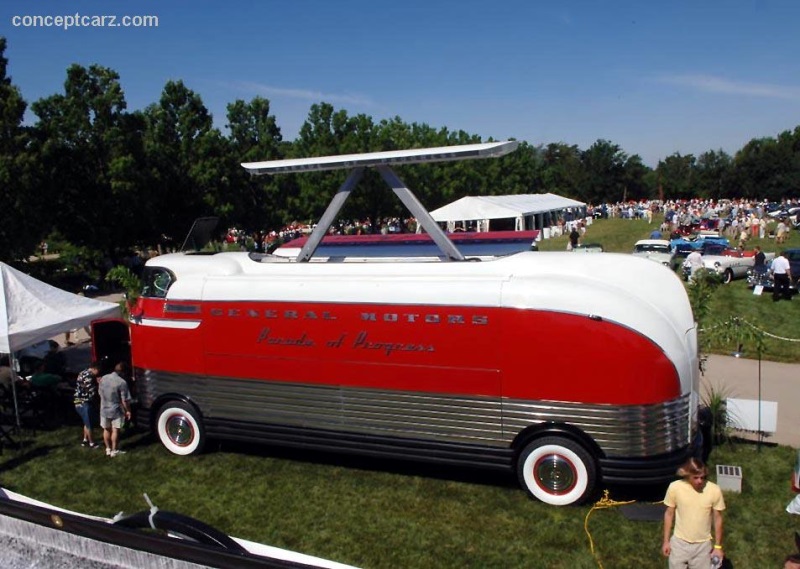Image credit: © conceptcarz.com (Reproduction Or reuse prohibited).
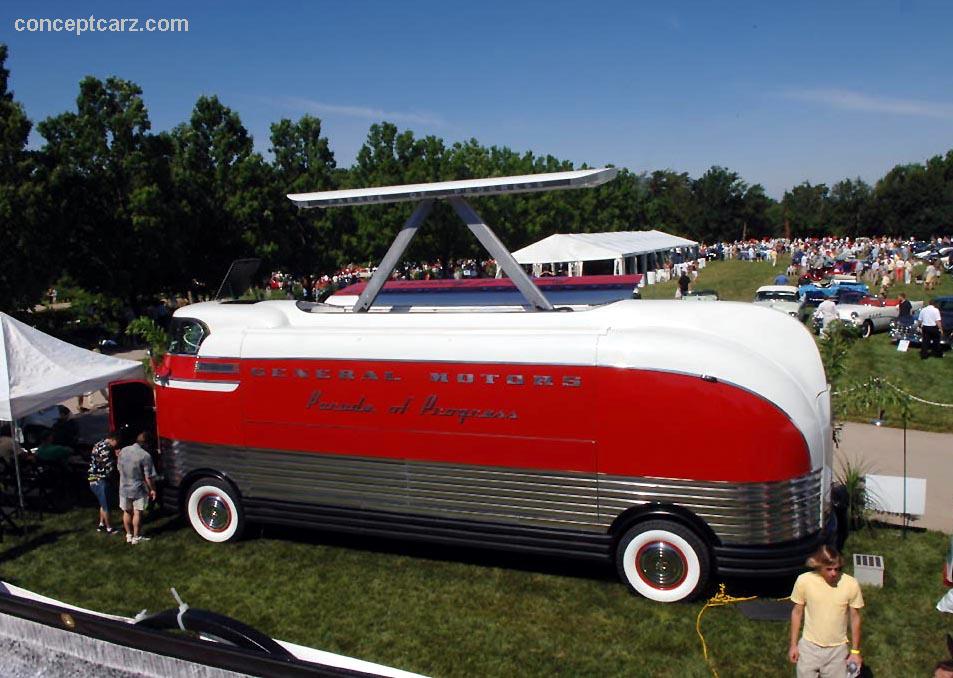
1950 GMC Futurliner Navigation
The 1930's
In 1933 and 1934 Chicago's World's Fair, known as 'A Century of Progress' was organized as a not-for-profit corporation in January of 1928. Its charter was to hold a World's Fair in Chicago in 1933.The 'A Century of Progress Exposition' was conceived as a 100-year anniversary commemorating the city of Chicago and a testament to the industrial and scientific achievements up to that time.
On February 11, 1936, the Parade of Progress made its debut in Lakeland, Florida using eight custom-built Streamliners. The Streamliners resembled large moving vans. This version of the Parade ran until Pearl Harbor in 1941. During this time the Parade stopped in 251 cities and played before audiences of more than twelve and one-half million people.
Billed by GM in their 1936 promotional literature as 'Silver-Topped Streamliners' and referred to as the 'World's Largest Highway Leviathans' at 33 feet from stem to stern, the 28-vehicle caravan, including nine support semis, was an impressive site.
It's hard for many of us to imagine this, but there were no 4-lane super highways in 1936 only 2-lane roads. It's been said that the top speed for the Streamliners was about 40 mph.
1940-1952 First Generation Futurliners
In 1940, 12 first-generation Futurliners were built to replace the original eight Streamliners. The Futurliner caravan consisted of 24 trucks, 11 passenger cars and three station wagons. The early show had five major exhibits, while the latter had 15, plus two Army trucks, which formed part of the Defense Exhibit. The most spectacular of the new pieces of equipment was the Aer-O-Dome tent. It seated 1,500 people and was built like an inverted umbrella with ribs exposed. In 1946, after a WWII hiatus, several of the Futurliners were in a Detroit parade to commemorate the fiftieth anniversary of the invention of the automobile.
1953-1956 Second Generation Futurliners
In 1953, the Futurliners were rebuilt into their second-generation form. In 1956, just three years after their rebuild, the popularity of the show waned and the Futurliners were either sold or donated. Approximately 13 million people in nearly 300 cities nationwide saw the 12 vehicles roll into their towns and enjoyed a free show that provided them with a glimpse into the future.
Twelve Futurliners were built and used by GM to transport the GM Parade of Progress show throughout the United States from 1941 to 1956.
The Futurliners transported dioramas and exhibits, featuring futuristic things such as: a microwave that fried an egg without burning a newspaper; a Ping-Pong game in stereophonic sound and; sound traveling over a beam of light produced by a flashlight.
The Futurliner is a massive bus-like vehicle, 33' long, 8' wide, 11'-7' tall vehicle with a whopping 248' wheelbase. An unusual feature of the Futurliner is dual (side-by-side) front wheels. Each wheel had its own set of brakes, brake drums, and bearings. Nearly all of the Futurliners had problems with their power steering pumps failing, presumably because of the tremendous force required to turn the wheels.
The pre-1953 Futurliners were powered by 4-cylinder diesel engines and 4x4 mechanical transmissions. The 1953 version, however, is powered by a 302 cubic-inch inline six-cylinder OHV GMC engine. The engine is a Korean War vintage four-speed Hydramatic automatic transmission that is bolted to the backside of another two-speed gearbox. This gives the driver the option of selecting from 8 forward speeds. Complicating this a bit more is another 3-speed PTO gearbox. To shift this gearbox, the driver must leave the cockpit (presumably with the vehicle stopped) and travel to the rear quarter of the vehicle and manually select one of the three gears. With this combination, the driver now has 24 selections to choose from. The restoration crew reports that the rear end has yet another gear reduction, but they haven't figured out quite how that works yet. In spite of the gearing ratios, some of the original 'Paraders,' as they referred to themselves, recall attainable speeds of not much more than 40 mph! The Futurliners packed two 45-gallon gasoline tanks!
The original Futurliners, prior to their 1953 refurbishing, had bubble canopies over the cockpit (driver's compartment), similar to a fighter plane of the era. This arrangement was brutally hot for the drivers and the vehicles were not air-conditioned! The cockpit is reached by climbing a stairway to the top of the 11'-7' vehicle. This positions the driver's head at about the 11' level and makes for a terrifying first-time experience when going under an overpass!
The vehicle has an incredible 19 access and display doors on it. Two massive 16x5' doors open to expose the display housed within the vehicle. A 16' lighting panel is attached to the top of the overhead doors and a large light bar rises from the roof another 7' up above the Futurliner for additional illumination. To provide electricity for all this lighting, a massive twin 6-71 200KW Detroit Diesel generator was used.
Because the brakes were so poor, one Futurliner rear-ended another and consequently, they were instructed to stay 300 feet apart. They all had radio receivers but only the lead and tail vehicles had transmitters. The Futurliners were nicknamed the 'Red Elephants.' The name 'Futurliner' was spelled without the 'E' in Future so GM could copyright or trademark the name.
No auction information available for this vehicle at this time.
Recent Sales of the GMC Futurliner
(Data based on Model Year 1950 sales)
GMC Futurliners That Failed To Sell At Auction
1950 GMC Futurliner's that have appeared at auction but did not sell.
| Vehicle | Chassis | Event | High Bid | Est. Low | Est. High |
|---|
Vehicles With Comparable Market Values
Similar sales to the range.
1950 GMC Futurliner
• Additional valuation insight and sales data• History
• Specifications
• Image gallery
